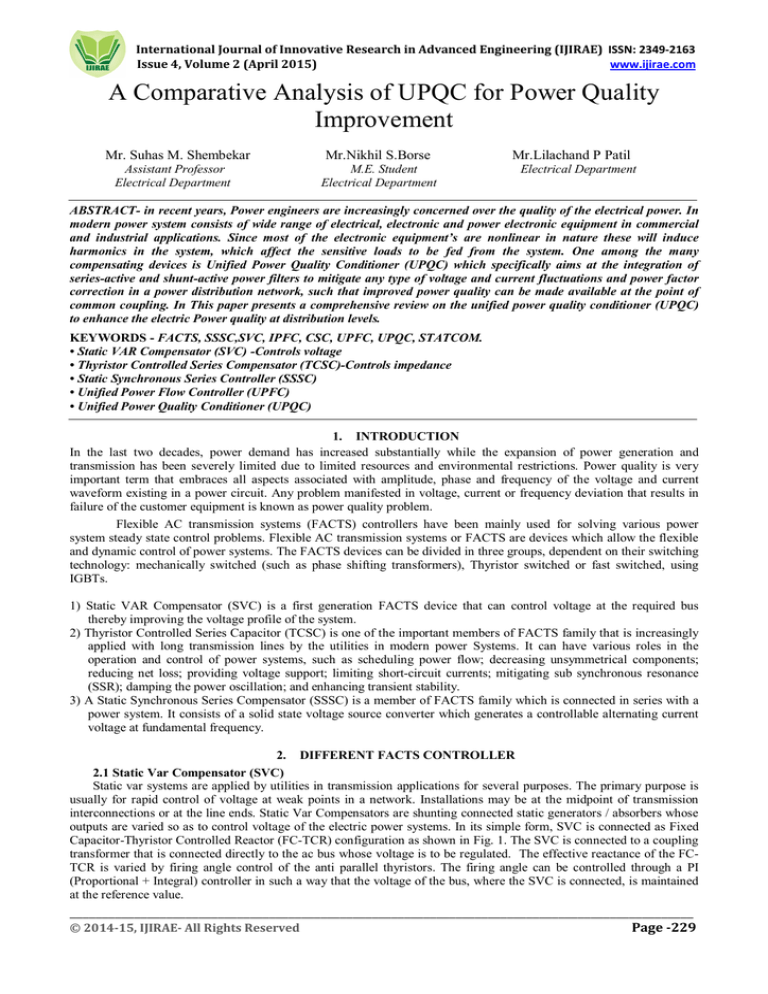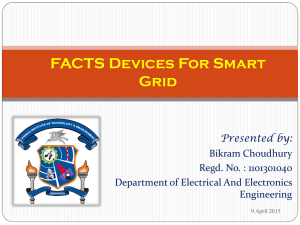
International Journal of Innovative Research in Advanced Engineering (IJIRAE) ISSN: 2349-2163
Issue 4, Volume 2 (April 2015)
www.ijirae.com
A Comparative Analysis of UPQC for Power Quality
Improvement
Mr. Suhas M. Shembekar
Assistant Professor
Electrical Department
Mr.Nikhil S.Borse
M.E. Student
Electrical Department
Mr.Lilachand P Patil
Electrical Department
ABSTRACT- in recent years, Power engineers are increasingly concerned over the quality of the electrical power. In
modern power system consists of wide range of electrical, electronic and power electronic equipment in commercial
and industrial applications. Since most of the electronic equipment’s are nonlinear in nature these will induce
harmonics in the system, which affect the sensitive loads to be fed from the system. One among the many
compensating devices is Unified Power Quality Conditioner (UPQC) which specifically aims at the integration of
series-active and shunt-active power filters to mitigate any type of voltage and current fluctuations and power factor
correction in a power distribution network, such that improved power quality can be made available at the point of
common coupling. In This paper presents a comprehensive review on the unified power quality conditioner (UPQC)
to enhance the electric Power quality at distribution levels.
KEYWORDS - FACTS, SSSC,SVC, IPFC, CSC, UPFC, UPQC, STATCOM.
• Static VAR Compensator (SVC) -Controls voltage
• Thyristor Controlled Series Compensator (TCSC)-Controls impedance
• Static Synchronous Series Controller (SSSC)
• Unified Power Flow Controller (UPFC)
• Unified Power Quality Conditioner (UPQC)
1. INTRODUCTION
In the last two decades, power demand has increased substantially while the expansion of power generation and
transmission has been severely limited due to limited resources and environmental restrictions. Power quality is very
important term that embraces all aspects associated with amplitude, phase and frequency of the voltage and current
waveform existing in a power circuit. Any problem manifested in voltage, current or frequency deviation that results in
failure of the customer equipment is known as power quality problem.
Flexible AC transmission systems (FACTS) controllers have been mainly used for solving various power
system steady state control problems. Flexible AC transmission systems or FACTS are devices which allow the flexible
and dynamic control of power systems. The FACTS devices can be divided in three groups, dependent on their switching
technology: mechanically switched (such as phase shifting transformers), Thyristor switched or fast switched, using
IGBTs.
1) Static VAR Compensator (SVC) is a first generation FACTS device that can control voltage at the required bus
thereby improving the voltage profile of the system.
2) Thyristor Controlled Series Capacitor (TCSC) is one of the important members of FACTS family that is increasingly
applied with long transmission lines by the utilities in modern power Systems. It can have various roles in the
operation and control of power systems, such as scheduling power flow; decreasing unsymmetrical components;
reducing net loss; providing voltage support; limiting short-circuit currents; mitigating sub synchronous resonance
(SSR); damping the power oscillation; and enhancing transient stability.
3) A Static Synchronous Series Compensator (SSSC) is a member of FACTS family which is connected in series with a
power system. It consists of a solid state voltage source converter which generates a controllable alternating current
voltage at fundamental frequency.
2. DIFFERENT FACTS CONTROLLER
2.1 Static Var Compensator (SVC)
Static var systems are applied by utilities in transmission applications for several purposes. The primary purpose is
usually for rapid control of voltage at weak points in a network. Installations may be at the midpoint of transmission
interconnections or at the line ends. Static Var Compensators are shunting connected static generators / absorbers whose
outputs are varied so as to control voltage of the electric power systems. In its simple form, SVC is connected as Fixed
Capacitor-Thyristor Controlled Reactor (FC-TCR) configuration as shown in Fig. 1. The SVC is connected to a coupling
transformer that is connected directly to the ac bus whose voltage is to be regulated. The effective reactance of the FCTCR is varied by firing angle control of the anti parallel thyristors. The firing angle can be controlled through a PI
(Proportional + Integral) controller in such a way that the voltage of the bus, where the SVC is connected, is maintained
at the reference value.
_________________________________________________________________________________________________
© 2014-15, IJIRAE- All Rights Reserved
Page -229
International Journal of Innovative Research in Advanced Engineering (IJIRAE) ISSN: 2349-2163
Issue 4, Volume 2 (April 2015)
www.ijirae.com
Fig No.1 Configuration of SVC
2.2 Thyristor Controlled Series Capacitor (TCSC)
TCSC is one of the most important and best known FACTS devices, which has been in use for many years to
increase the power transfer as well as to enhance system stability. The main Circuit of a TCSC is shown in Fig. 2. The
TCSC consists of three main components: capacitor bank C, bypass inductor L and bidirectional Thyristor SCR1 and
SCR2. The firing angles of the Thyristor are controlled to adjust the TCSC reactance in accordance with a system control
algorithm, normally in response to some system parameter variations. According to the variation Of the Thyristor firing
angle or conduction angle, this process can be modeled as a fast switch between corresponding reactance’s offered to the
power system.
Fig. 2 Configuration of a TCSC
2.3 Static Synchronous Series Compensator (SSSC)
The SSSC is one of the most recent FACTS devices for power transmission series compensation. It can be
considered as a synchronous voltage source as it can inject an almost sinusoidal voltage of variable and controllable
amplitude and phase angle, in series with a transmission line. The injected voltage is almost in quadrature with the line
current. A small part of the injected voltage that is in phase with the line current provides the losses in the inverter. Most
of the injected voltage, which is in quadrature with the line current, provides the effect of inserting an inductive or
capacitive reactance in series with the transmission line. The variable reactance influences the electric power flow in the
transmission line. The basic configuration of a SSSC is shown in Fig. 3.
Fig. 3 Simplified diagram of a SSSC
_________________________________________________________________________________________________
© 2014-15, IJIRAE- All Rights Reserved
Page -230
International Journal of Innovative Research in Advanced Engineering (IJIRAE) ISSN: 2349-2163
Issue 4, Volume 2 (April 2015)
www.ijirae.com
2.4Unified Power Flow Controller (UPFC)
The basic configuration of a UPFC is shown in Fig. 4. The UPFC is capable of both supplying and absorbing
real and reactive power and it consists of two ac/dc converters. One of the two converters is connected in series with the
transmission line through a series transformer and the other in parallel with the line through a shunt transformer. The dc
side of the two Converters are connected through a common capacitor, which provides dc voltage for the converter
operation. The power balance between the series and shunt converters is a pre requisite to maintain a constant voltage
across the dc capacitor. As the series branch of the UPFC injects a voltage of variable magnitude and phase angle, it can
exchange real power with the transmission line and thus improves the power flow capability of the line as well as its
transient stability limit. The shunt converter exchanges a current of controllable magnitude and power factor angle with
the power system. It is normally controlled to balance the real power absorbed from or injected into the power system by
the series converter plus the losses by regulating the dc bus voltage at a desired value.
Fig. 4 Configuration of UPFC
2.5 Unified Power Quality Conditioner(UPQC):
Among the available FACTS devices, the Unified Power Flow Controller (UPFC) is the most versatile one that
can be used to enhance steady state stability, dynamic stability and transient stability A multi-level converter is proposed
to increase the converter operation voltage, avoiding the series connection of switching elements. However, the
multilevel converter is complex to form the multi converter UPQC consists of two VSC’s. The two voltage source
converters are connected with a commutation reactor and high pass output filter to prevent the flow of switching
harmonics in to the supply. The voltage source converters are controlled by pulse width modulation (PWM) techniques.
Fig. 5: UPQC with controller arrangement
_________________________________________________________________________________________________
© 2014-15, IJIRAE- All Rights Reserved
Page -231
International Journal of Innovative Research in Advanced Engineering (IJIRAE) ISSN: 2349-2163
Issue 4, Volume 2 (April 2015)
www.ijirae.com
3 COMPARITIVE POINTS
3.1 Settling time:
The comparison between different facts controller on the basis of their settling time in post fault period is shown
in following table.
Two-area Power
System With
UPQC
UPFC
TCSC
SVC
SSSC
Power System Stability
Enhancement
YES
YES
YES
YES
YES
Settling time in post fault period
(in seconds)
0.08
0.6
1.5
7
11
3.2 Load Flow:
Facts devices
UPQC
UPFC
SSSC
TCSC
SVC
Load Flow
High
High
Medium
Low
Low
Facts devices
UPQC
UPFC
SSSC
TCSC
SVC
Voltage control
High
High
Low
High
High
Facts devices
UPQC
UPFC
SSSC
TCSC
SVC
Transient stability
High
Medium
High
Low
Medium
3.3 Voltage control:
3.4 Transient stability:
3.5 Device used:
Facts devices
UPQC
UPFC
SSSC
TCSC
SVC
3.6 Parameter controlled:
Facts devices
UPQC
UPFC
SSSC
TCSC
SVC
3.7 Effective Location:
Facts devices
UPQC
UPFC
SSSC
TCSC
SVC
Device used
Series and shunt APFs with DC capacitor
Combination of sssc and statcom
Voltage source converter
capacitor bank , bypass inductor and bidirectional thyristors
Fixed Capacitor-Thyristor
Parameter
Series Active and Reactive power
Real time control and dynamic compensation
Exchange active and reactive power with transmission system
Series active power
Series reactive power
Location
At the point of common coupling
At the point of installation
At midpoint of transmission line
At the end of transmission line where reactive power or voltage support is necessary
at the midpoint of transmission interconnections or at the line ends
_________________________________________________________________________________________________
© 2014-15, IJIRAE- All Rights Reserved
Page -232
International Journal of Innovative Research in Advanced Engineering (IJIRAE) ISSN: 2349-2163
Issue 4, Volume 2 (April 2015)
www.ijirae.com
4. CONCLUSION
The power quality problems in distribution systems are not new but customer awareness of these problems
increased recently. It is very difficult to maintain electric power quality at acceptable limits. One modern and very
promising solution that deals with both load current and supply voltage imperfections is the Unified Power Quality
Conditioner (UPQC). This paper presented review on the UPQC to enhance the electric power quality at distribution
level. The UPQC is able to compensate supply voltage power quality issues such as, sags, swells, unbalance, flicker,
harmonics, and for load current power quality problems such as, harmonics, unbalance, reactive current and neutral
current. In this paper several facts device configurations have been discussed. Among all these configurations, UPQC
could be the most interesting solution for power quality improvement.
5. REFERENCES
1) D. Murali, oct 2010, “Comparision of FACTS devices for power system stability Enhancement” IJCA, in vol 8-no 4.
2) RanjitkumarBindal, Apr 2014, “A review of Benefits of FACTS devices in power system” IJEAT ISSN:2249-8958,
vol-3, Issue-4
3) VJSAireshkumar G Mathad, march 2013, “Review on comparision of FACTS controllers for power system stability
enhancement” IJSARP, vol 3,Issue3.
4) Mr. Suhas M Shembekar, “Conditioning of Power Quality in transmission network using UPQC” IJRAT page no.4350,vol.3,no.1,jan2015.
5) Mr.ShaktisinhN.Gohil,” A comparative analysis of UPQC for Power Quality Improvement” JIKREE,Nov12 to
Oct13,vol 2, issue 2.
6) B Jyoti,”Analysis Of Unified Power Quality Conditioner During Voltage and Swell conditions” page no.85-91, vol 2,
issue1.jan-feb 2012
7) Tan Zhill “A New control strategy of UPQC in Three Phase Four wire system” IEEE Transaction 2007.
8) H. Akagi, Edson HirokazuWantanbe and Mauricio Aredes, “Instantaneous Power Theory and Applications to Power
Conditionong” IEEE Press 2007.
9) A. Ghosh, G. Ledwich “Power Quality Enhancement Using CustomPower Devices” Kluwer Academic Publisher,
2002. ISBN 1-4020 7180-9.
10)H. Fujita and H. Akagi, “The unified power quality conditioner: The integration of series And shunt active filters,”
IEEE Trans. Power Electron., vol. 13, no. 2, pp. 315–322, Mar.1998.
_________________________________________________________________________________________________
© 2014-15, IJIRAE- All Rights Reserved
Page -233




